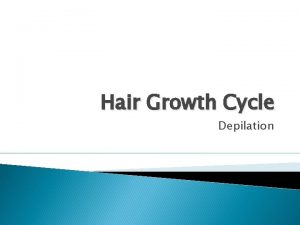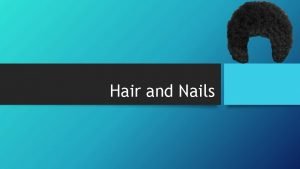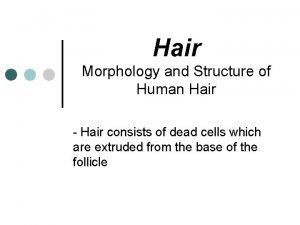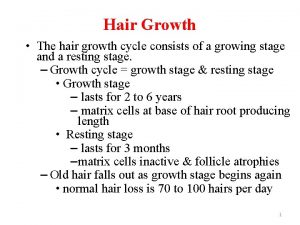Hair Structure Growth hair structure hair growth hair






- Slides: 6

Hair Structure & Growth hair structure hair growth hair life cycle

Basic Hair Structure This diagram shows the three layers of a hair follicle, the cuticle, cortex and medulla. The cuticle is made up of scales and is translucent (the hair colour shows through it). It has a protective function. The cortex forms the bulk of the hair and it is in this part of the hair that the chemical changes of perming and neutralising take place. The medulla is an air space in the middle of the hair and may not always be present.

Hair Growth There are two main type of hair on the human body; • Fine vellus hair which grows on the body. • Stronger terminal hair which grows on the scalp and makes up eyebrows, eyelashes, beards and moustaches. However there is a third type of hair, lanugo hair, it is only found on human foetuses and is even finer than vellus hair.

Hair Growth The scalp ( and skin) is divided into two layers: The outer layer – the epidermis – is the outer protective layer of skin. It is constantly shedding itself, losing dead skin cells. When this happens excessively on the scalp it is known as dandruff. The inner layer – the dermis – is the thickest and most important part of the skin. It is where you will find; epidermis

Hair Growth Hair is made of the protein keratin, all proteins are made up of amino acids. The hair you see emerging from the scalp is dead, it does not hurt when we cut through it, or when chemicals such as perm lotions or bleaches are put onto it. But at the base of the follicle the hair is alive and growing, that is why we can feel someone pulling our hair because it is attached to the scalp by its roots, sitting in tiny pockets called the hair follicle. The sebaceous gland is also attached to the hair follicle and produces sebum, the hair’s natural oil. The sebum flows around the hair root and outwards onto the scalp surface. If too much sebum is produced, the scalp and hair will be too greasy, but if too little sebum is produced the hair and scalp will be too dry. The erector pili muscle is attached to the hair root and contracts to pull the hair upright, creating the goose pimp The heart pumps blood containing food and oxygen ( needed to make new keratin) through our arteries towards the skin surface. The arteries become small blood capillaries in the dermis, where they supply into the bottom of the hair root or follicle to feed the dermal papilla. The more blood flowing towards the hair papilla, the more the hair will grow.

hair life growth cycle Hair growth needs energy to grow. The papilla oxidation of glucose provides that energy. The blood in turn supplies oxygen and glucose to the papilla. Hair grows from the bottom of its root at the dermal papilla, where new cells are constantly being produced. These soft cells become hardened to form strong hair above the skin surface. The average rate of hair growth is 1. 25 cm. The growing stage of the hair is called the anagen stage. When the hair starts to go into its resting stage, it is said to be in the catgen stage. The resting stage is called the telogen stage Anagen Catagen Telogen Active growth 1 -7 years (average 3 years) Breakdown And change 2 weeks Resting Stage 3 -4 months The only way to improve the condition of the hair permanently is through the blood supply to the papilla Anagen Regrowth The thickness, shape and texture of the hair is determine at this stage











